The back of the Italianate-style house overlooks a man-made pond, which landscape architect Sara Furlan edged
with native wetland plants. She seeded the sloped shoreline with no-mow fescue grasses.
“Our job begins where the windows and doors end, but it’s still always a good idea to have us there before breaking ground,” says landscape architect Sara Furlan of Mariani Landscape, who was called in early to help position a magnificent Lake Forest manse designed by Witmer & Associates. She ultimately situated it at the center of a well-thought-out landscape that perfectly suits a couple with a large extended family—including grandchildren who need room to romp—while giving the homeowners the vast, calming view of their dreams.
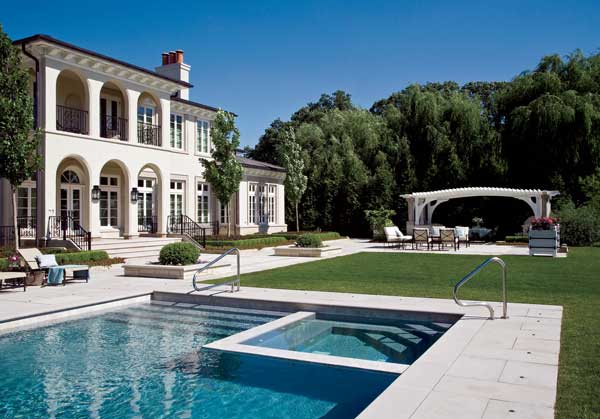
The terrace features a pool with a hot tub and a lawn where the grandchildren play. The grass gives the eye a
place to rest, Furlan points out. Limestone from Indiana and Wisconsin was used in the hardscaping.
The house’s positioning wasn’t just a question of which side should face the street. The lot the clients had purchased years earlier sloped down toward a man-made pond (owned by the neighborhood association) with a nature preserve beyond it. The clients loved the view, but Furlan knew that unlevel ground can be challenging to work with, both visually and practically. Erosion is always a concern with sloping terrain; plus, the couple wanted a swimming pool. To situate the house, Furlan outlined a parcel of tableland (the flattest, most livable space atop a bluff) that was just the right size and set the house on it in just the right way to accommodate everything from the driveway in the front yard to the pool in the back.
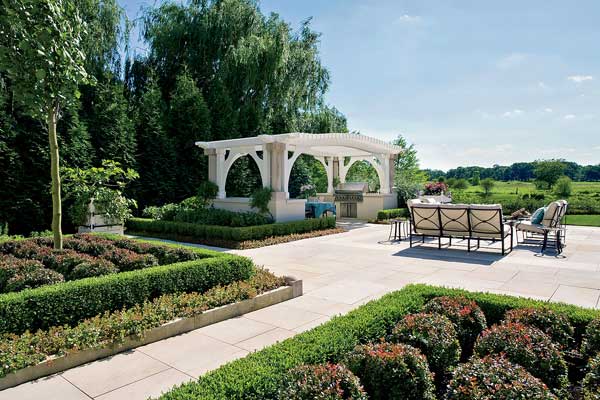
A pergola at one end of the yard balances the swimming pool at the other.
“We wanted the space immediately around the house to read as level,” says Furlan. She designed an elegant stone retaining wall around the periphery of the backyard and gave her clients a proper terrace, with flower beds and planters, a pool, an outdoor kitchen, and multiple seating areas. The grandness of the property is best experienced from the house’s back entrance on a pretty summer day: The owners can walk out through French doors, go down a few steps, stroll across the lush green lawn, and descend a stone stairway—which echoes the one at the level of the house—to the pond’s edge.
photography by linda oyama bryan
styling by christine oyama
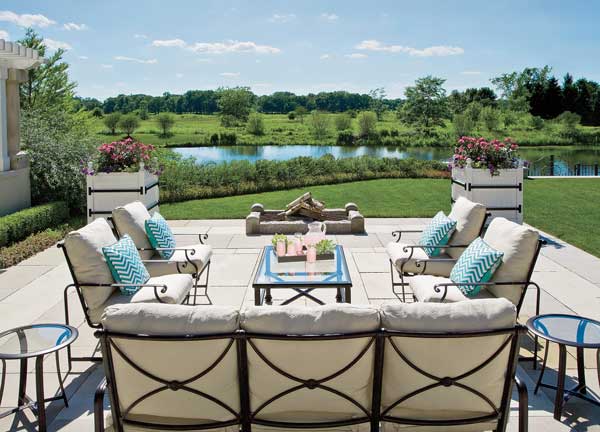
This seating area has a fire pit and a vista of the nature preserve on the other side of the pond.
Furnishings were kept simple so as not to distract from the view.
But the clients’ property doesn’t stop there; they own land on the other side of the pond, too. Furlan had a lot of territory to cover.
She started by listening to the architecture of the house. Since it was built in an Italianate style, she decided to give some of the vegetation surrounding it a bit of Tuscan flair. “When people think of Tuscany, they think of cypress trees—those tall, cylindrical trees,” she says. But that variety of cypress doesn’t thrive here. Instead, Furlan substituted six long and lean tulip trees, three on either side of the back entrance. Not only do they recall la dolce vita, but they also allowed Furlan to honor her clients’ only real rule: No blocking the view. (“I found a variety that stays nice and skinny,” she explains.) Who knew Tuscany could exist in the northern suburbs of Chicago?
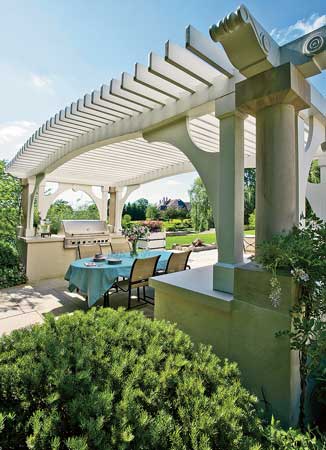
An outdoor kitchen is designed for garden-to-table alfresco dining.
Another Italian touch: She brings in lemon, lime, fig, and grapefruit trees for the summer months, establishing them in freestanding planters at the four corners of the seating area near the grill. They are stored in a greenhouse during the fall and winter, when other seasonal plants take their place.
Still, most of the landscape elements are native to the Midwest, particularly those by the pond. Furlan specified plants for the pond’s edge—water lilies and other aquatic vegetation that would look lovely and help fend off wild geese (the gaggles tend to stay away from tall grasses that might hide predators).
Back on dry land, the terrace hardscaping is made up of two complementary varieties of locally sourced limestone—Indiana and Valders. Large raised flower beds filled with simple boxwood and barberry (“to avoid being too sweet or delicate”) line the back of the house, while four smaller beds planted with boxwood and annuals define the four corners of the lawn.
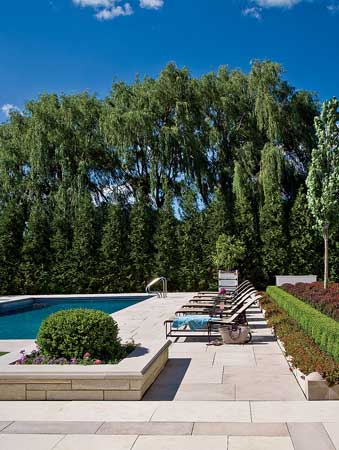
Unfussy barberry and boxwood fill stone planters; in the spring, alliums pop up,
adding height and boosting the color quotient. Evergreens provide a natural privacy fence behind the pool.
Though there is definite symmetry at play, the effect is balanced rather than mirror perfect. The pool and the pergola, on opposite sides of the lawn, “have similar visual weight,” Furlan says, but they are obviously very different structures. “The pool is flat and has more volume and color, while the pergola has its own kind of volume. Each side has things happening, but neither side feels overwhelmed.”
The pergola, indeed, has things happening—it is home to a full outdoor kitchen with a grill, a rotisserie, burners, a sink, a refrigerator, and generous counter space for prepping and serving food. There is another grill, as well as a vegetable and herb garden, near the door to the house’s main kitchen, making dining a true garden-to-table situation. “The owner loves to cook and is always picking fresh ingredients from her garden,” says Furlan.
As for the extended family, they are happy to take full advantage of all the amenities. Just as the owners had imagined.
photography by linda oyama bryan
styling by christine oyama



Comments are closed.